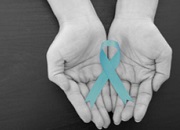
The American Cancer Society (ACS) estimates more than 22,000 new cases of ovarian cancer will be diagnosed in the United States this year. Knowing about the risk factors and symptoms can help you protect yourself.
Risk factors
According to the ACS, factors that may affect a woman's risk of ovarian cancer include:
Reproductive history. Women who have been pregnant have a lower risk of ovarian cancer than women who have not. Breastfeeding may further lower risk as well.
Obesity. Studies suggest that obese women (those with a body mass index of at least 30) may have a higher risk of developing ovarian cancer.
Fertility drugs. Some studies suggest a link between long-term use of some fertility drugs and an increased risk of ovarian cancer.
Family history. Women with a first-degree relative—mother, daughter or sister—who has had ovarian cancer are at higher risk too. This is especially true if one of those relatives developed the cancer at a young age. A family history of breast cancer or colon cancer may also increase risk.
A history of cancer. Women with a personal history of some cancers, including breast, colon or cervical cancer, have a higher risk for ovarian cancer.
Age. Ovarian cancer risk increases with age. Half of all cases occur in women older than 63. However, younger women can and do develop ovarian cancer.
Hormone therapy. Some studies have shown that women who take hormone therapy after menopause have a higher risk for ovarian cancer. In one study, the risk was increased most in women who took estrogen-only hormone therapy, and rose as women took the drug for a longer time. Other studies have found no difference in risk based on hormone therapy.
Inherited gene mutations. Women who inherit a mutation in the BRCA1 or BRCA2 gene have a higher risk of developing ovarian cancer. These mutations are about 10 times more common in women who are Ashkenazi Jewish than those in the general population.
Talcum powder. Some studies show a slightly increased risk of ovarian cancer in women who have used talcum powder on the genital area. The link may be explained by the fact that some of these powders used to contain asbestos, according to the ACS.
Symptoms
Ovarian cancer often doesn't have specific symptoms in its early stages. For that reason, the disease often isn't found until it has advanced.
When they appear, early symptoms can include a sense of discomfort in the pelvic region as well as indigestion, gas and bloating that can't be explained.
Symptoms of more advanced ovarian cancer may include:
- Abnormal bleeding from the vagina.
- Pain and swelling of the abdomen.
- Nausea, diarrhea, constipation or frequent urination.
- A feeling of fullness even after a light meal.
- Weight gain or loss with no known reason.
Experiencing any of these symptoms doesn't necessarily mean you have ovarian cancer. But the National Cancer Institute recommends that you check with your doctor if you notice any of them.
Following up
If you have symptoms of ovarian cancer, your doctor may use some of the following to check for the disease:
Medical history review. This includes information on symptoms, past health problems and family history of cancer.
Pelvic and rectal exam. A physical examination of the uterus, vagina, ovaries, fallopian tubes, bladder and rectum.
Imaging tests. Ultrasound, computed tomography (CT) or magnetic resonance imaging (MRI) tests may be used to look for tumors.
Biopsy. Removing tissue from the ovary and physically examining it is the only way to definitively rule out or diagnose ovarian cancer.
reviewed 7/2/2018